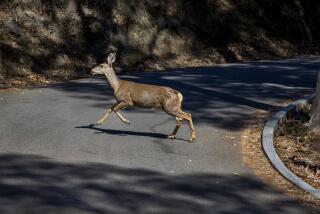PRIVATE FACES, PUBLIC PLACES : Souvenirs From the Safari Queen of Burbank
- Share via
Down the road from Fuddruckers’, where Dr. David Burbank’s sheep must have grazed on Rancho La Providencia, Inge Dougherty runs a taxidermist shop.
During hunting season, she wears tight, tan “Out of Africa” clothes to work, with an embroidered head of a lion on her breast. On her office walls are pictures of Inge in Africa: Inge with dead elephant, Inge with dead zebra, Inge with dead leopard, Inge the intrepid hunter. “I’m not calling what I do killing,” she says. “It’s hunting. It’s a sport. Very clean and very wonderful.”
She has jet black hair, full of spring, and emerald eyes. She wears a leopard-claw ring, among other items of heavy gold and diamond jewelry. It seems rather exotic for a shopkeeper in the flat emptiness of the deep San Fernando Valley. “I have been burglarized many, many times,” she shrugs, “but at least when they come, they must know I can shoot.”
She is an adventurer in the Barbara Stanwyck “get off my land before I shoot you” mold: 50ish, husky-voiced with a clipped German accent, heavy-skinned, tough, guaranteed to appeal to men who remember when anyone could shoot anything. Simple days of great white hunters.
Even now, despite the rules and restrictions, the fussing government agencies, there are gazelles and deer aplenty to mount for private customers. $295 for head only with glass eyes and plastic teeth (“we used to break the jaw but bone was difficult”). $1,500 or so for full animal, rampant or flat-footed.
Huge heads with amazing primeval horns hang together on a workshop wall waiting for their collectors. A screeching baboon snarls in perpetual alarm, a wart-hog and a jackal, perfectly re-created, are captured forever in that moment of the hunter’s ultimate mastery. Killing maketh the man.
The trophies of death are clean and tidy: the skinning done in the field, the blood long gone. Battlegrounds are not this way. Dougherty talks of living through World War II in Nuremberg--of saturation bombing, of weeks in a bunker, the hunger and cold. “Pictures you never forget.” Another shrug.
She despises softness, takes it for hypocrisy and weakness. “City people--they say, ‘Oh, you don’t shoot those pretty little creatures with those sweet little eyes!’ What we’re doing here, we’re preserving animals. Why put the animal in the trash?”
The business relies on hunters. Dougherty will not touch “domestics.” “You cannot satisfy a pet owner,” she explains. “This dog looks at you in a certain way for 10 years, and the most professional taxidermist in the world could not capture just that look. The most unhappy people I have known here are people with little parakeets. These people talk to the bird through the cage, they kiss the little bird every day for years. How can we capture the look in the eyes of that little bird?”
Enough wild stuff survives to keep the workshop busy. Enough skins and horns delivered to the shop (“we don’t see bodies here”), enough trophies to mark the real men who stared at a life and were not afraid to take it.
“Yesterday, a customer brought his grandson who had just shot his first deer. Middle-class people, they like to go on a weekend driving in the country. Comes to hunting season, the family is together--grandson, father and son.”
It is changing, nevertheless. Once there were deer, elk, mountain lions, bears, birds. “Maybe 20 years ago, we had three or four hundred deer heads in a season. Now maybe you have no more than 20.”
In the window, a giant polar bear is reared forever in imaginary attack, snarling stuffed Dobermans wait for studio rental, a make-believe stone fireplace re-creates the hunting lodge of yore. It is a strange world to find in the flatlands of Burbank: opposite the RV lot, down a bit from the defunct bowling paraphernalia store, a celebration of bucolic drive-by shootings.
Killing fields all around us.
More to Read
Sign up for The Wild
We’ll help you find the best places to hike, bike and run, as well as the perfect silent spots for meditation and yoga.
You may occasionally receive promotional content from the Los Angeles Times.






